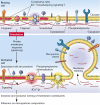Red blood cell vesiculation in hereditary hemolytic anemia
- PMID: 24379786
- PMCID: PMC3862113
- DOI: 10.3389/fphys.2013.00365
Red blood cell vesiculation in hereditary hemolytic anemia
Abstract
Hereditary hemolytic anemia encompasses a heterogeneous group of anemias characterized by decreased red blood cell survival because of inherited membrane, enzyme, or hemoglobin disorders. Affected red blood cells are more fragile, less deformable, and more susceptible to shear stress and oxidative damage, and show increased vesiculation. Red blood cells, as essentially all cells, constitutively release phospholipid extracellular vesicles in vivo and in vitro in a process known as vesiculation. These extracellular vesicles comprise a heterogeneous group of vesicles of different sizes and intracellular origins. They are described in literature as exosomes if they originate from multi-vesicular bodies, or as microvesicles when formed by a one-step budding process directly from the plasma membrane. Extracellular vesicles contain a multitude of bioactive molecules that are implicated in intercellular communication and in different biological and pathophysiological processes. Mature red blood cells release in principle only microvesicles. In hereditary hemolytic anemias, the underlying molecular defect affects and determines red blood cell vesiculation, resulting in shedding microvesicles of different compositions and concentrations. Despite extensive research into red blood cell biochemistry and physiology, little is known about red cell deformability and vesiculation in hereditary hemolytic anemias, and the associated pathophysiological role is incompletely assessed. In this review, we discuss recent progress in understanding extracellular vesicles biology, with focus on red blood cell vesiculation. Also, we review recent scientific findings on the molecular defects of hereditary hemolytic anemias, and their correlation with red blood cell deformability and vesiculation. Integrating bio-analytical findings on abnormalities of red blood cells and their microvesicles will be critical for a better understanding of the pathophysiology of hereditary hemolytic anemias.
Keywords: enzyme disorder; erythrocyte; hemoglobinopathy; hemolytic anemia; membrane disorder; microvesicle; red blood cell.
Figures


Similar articles
-
Red cell vesiculation--a common membrane physiologic event.J Lab Clin Med. 1986 Oct;108(4):315-24. J Lab Clin Med. 1986. PMID: 3760672
-
Squeezing for Life - Properties of Red Blood Cell Deformability.Front Physiol. 2018 Jun 1;9:656. doi: 10.3389/fphys.2018.00656. eCollection 2018. Front Physiol. 2018. PMID: 29910743 Free PMC article. Review.
-
Use of Laser Assisted Optical Rotational Cell Analyzer (LoRRca MaxSis) in the Diagnosis of RBC Membrane Disorders, Enzyme Defects, and Congenital Dyserythropoietic Anemias: A Monocentric Study on 202 Patients.Front Physiol. 2018 Apr 27;9:451. doi: 10.3389/fphys.2018.00451. eCollection 2018. Front Physiol. 2018. PMID: 29755372 Free PMC article.
-
Erythrocyte phospholipid organization and vesiculation in hereditary high red cell membrane phosphatidylcholine hemolytic anemia.J Lab Clin Med. 1989 Mar;113(3):278-84. J Lab Clin Med. 1989. PMID: 2926237
-
[Reduced deformability of erythrocytes as a common denominator of hemolytic anemias].Wien Med Wochenschr. 1986;136 Spec No:14-6. Wien Med Wochenschr. 1986. PMID: 3548086 Review. German.
Cited by
-
Malaria-associated adhesion molecule activation facilitates the destruction of uninfected red blood cells.Blood Adv. 2022 Nov 8;6(21):5798-5810. doi: 10.1182/bloodadvances.2021006171. Blood Adv. 2022. PMID: 35349634 Free PMC article.
-
Roles and Applications of Red Blood Cell-Derived Extracellular Vesicles in Health and Diseases.Int J Mol Sci. 2022 May 25;23(11):5927. doi: 10.3390/ijms23115927. Int J Mol Sci. 2022. PMID: 35682606 Free PMC article. Review.
-
RedTell: an AI tool for interpretable analysis of red blood cell morphology.Front Physiol. 2023 May 26;14:1058720. doi: 10.3389/fphys.2023.1058720. eCollection 2023. Front Physiol. 2023. PMID: 37304818 Free PMC article.
-
Circulating Extracellular Vesicles and Endothelial Damage in Sickle Cell Disease.Front Physiol. 2020 Sep 3;11:1063. doi: 10.3389/fphys.2020.01063. eCollection 2020. Front Physiol. 2020. PMID: 33013455 Free PMC article. Review.
-
Oxidative stress and phosphatidylserine exposure in red cells from patients with sickle cell anaemia.Br J Haematol. 2018 Aug;182(4):567-578. doi: 10.1111/bjh.15441. Epub 2018 Jun 25. Br J Haematol. 2018. PMID: 29938778 Free PMC article.
References
Publication types
LinkOut - more resources
Full Text Sources
Other Literature Sources

